Las Cruces Bankruptcy & Debt Lawyer, New Mexico
Sponsored Law Firm
-
 x
x

Click For More Info:
-
Litty Law Group, P.C.
500 Marquette Ave NW Suite 1200 Albuquerque, NM 87102» view mapBankruptcy & Debt and Immigration Law Albuquerque’s Attorney
I’m Jon Litty and I’m here to serve you, Albuquerque! I will fight to get you what you rightfully deserve.
505-862-5061
Bradley A. Springer
Litigation, Administrative Law, Credit & Debt, Personal Injury
Status: In Good Standing
Oralia Franco
Personal Injury, Bankruptcy, Credit & Debt, Consumer Bankruptcy
Status: In Good Standing
 Jon Litty Albuquerque, NM
Jon Litty Albuquerque, NM Practice AreasExpertise
Practice AreasExpertise
